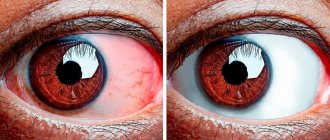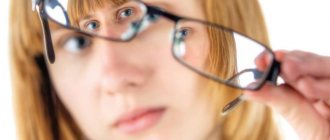Vision minus 5, which is called myopia or myopia, can be caused by hereditary predisposition, significant stress on the visual analyzer, stress and a sedentary lifestyle. In this case, a person loses the ability to see objects that are located at a considerable distance, headache, dizziness and weakness appear. Restoring vision is only possible if it is not caused by bad heredity.
Treatment of myopia consists of following a daily routine, a balanced diet and performing eye exercises.
Main causes of visual impairment
- 8.1 Video: Childhood myopia: myths and reality
- 9.1 Video: Bates Method for Restoring Vision
Critical loads on the organs of vision are the main reason. The structure of the eyes ensures their long-term functionality only when the muscles of the eye lens are relaxed . In this position, a person clearly sees objects at a distance of about 0.5–5 meters. This is the kind of vision that was required for hunting and daily life. To clearly see objects closer or further from this zone, you need to change the thickness of the lens, and to do this, strain your muscles excessively. If you work in this mode for a long time, the muscles become exhausted, atrophy and cannot change the thickness of the lens, the image becomes unclear, and visual acuity decreases. We spend a lot of time at the computer or reading books, without maintaining physiological distance.
Eye strain
Table. Other causes of visual impairment.
| Causes of loss of visual acuity | Short description |
| Unbalanced diet | The organs of vision are very complex in structure and require constant and adequate nutrition. Modern diets rarely contain a full range of vitamins, macro- and microelements. All this has an extremely negative effect on the eyeball, lens, cornea, etc. They lose their elasticity and cannot properly respond to changes in the distance to the object in question. |
| Age-related changes | Like the entire human body, the eyes lose their original capabilities over time. But this phenomenon is very individual. There are many elderly people who have excellent vision into old age, and many young people with obvious signs of impairment. |
| Diseases | Both eye diseases and complications from other diseases can lead to vision loss. |
| Heredity | Previously, only the strongest and healthiest people survived due to natural selection. Today medicine saves very heavy babies with various deviations of physiological development. Eye pathologies are inherited, therefore, children of parents with poor vision will have the same problem. |
Poor vision is inherited
What is minus five vision?
A pathological change in the length of the eyeball towards increase is called myopia or myopia. Myopia comes in several degrees:
- Weak – slight increase in the apple, up to three diopters;
- Medium – a significant increase, up to six;
- High – more than six.
Myopia develops in childhood, usually the first manifestations begin around 7 years. There are several reasons for this violation:
- Genetics - if one or both parents have minus five, most likely the child will also have myopia;
- Weakness of accommodative muscles - leads to stretching of the eyeball;
- Increased stress on the eyes - with the start of school, the stress experienced by the little person increases;
- Unfavorable environment - unbalanced diet, lack of vitamins, insufficient lighting when working at school and at home;
- Computers and digital devices - many children spend a lot of time uncontrollably on gadgets, overloading their eyes.
Minus five is moderate myopia. People with minus five vision, finding themselves on the street without correction means, cannot distinguish faces at a great distance. It is also difficult to see the bus number and letters in store windows. Acquaintances are recognized solely by their manner of movement - the contours look blurry. Reading is difficult - you have to hold the book very close to your eyes. A child with minus five vision cannot see from the board, even from the first desk. In the absence of correction, learning suffers.
How is visual acuity 0.5 determined?
In Russia, the rules for determining visual acuity have not changed since the times of the USSR and are determined by fractions of a unit. Indicator 1.0 – normal vision, 1.2–0.1 – visual acuity is reduced. The check is done according to the Sivtsev or Golovin table; there is no difference in the technology itself, only the signs differ. One contains the letters of the alphabet, and the other contains circles with slots.
Sivtsev table
There are 12 rows in the tables, each with its own size. At the top are the largest letters or circles; a person with normal vision should see them from a distance of 50 meters. A person with normal vision should be able to distinguish the bottom row from a distance of 2.5 meters. On the right of the rows, visual acuity is indicated when tested from a distance of 5 meters. The first mandatory check is done for children upon entering kindergarten and school. But parents should not expect a mandatory check; the sooner the doctor detects abnormalities, the better. In most cases, vision can be completely restored; if for some reason this is not possible, the child is prescribed glasses. Wearing glasses prevents further deterioration of vision.
Both eyes are checked in turn. If a patient from a distance of 5 meters sees all the signs or letters of the tenth line from the top, then his vision is 1.0, if he clearly distinguishes only up to the fifth line from the top, then his visual acuity is, accordingly, 0.5.
Golovin table for measuring visual acuity
How to choose glasses for myopia?
So, how to choose the right glasses for myopia? First, you should make an appointment with a specialist, who should conduct a thorough examination. He will determine the exact degree of vision loss, evaluate binocular vision, tell you what glasses will be used to correct myopia, whether minus or plus lenses are needed for this, and, if necessary, prescribe medications that will help relieve eye strain.
We remind you that it is extremely important that all of the above procedures are performed by a highly qualified ophthalmologist, since illiterate wearing of glasses for myopia can have a lot of consequences. Plus, the wrong choice of products for vision correction quite often negatively affects the success of treatment. After examination by a specialist, you can safely order glasses for myopia. The color and shape of the frame are selected taking into account individual preferences.
What causes vision loss to 0.5?
There may be several reasons, some can be corrected and some cannot.
- Anatomical reasons . The cornea, vitreous body of the eyeball, or lens changes.
- Refractive errors . The distance between the lens and the posterior wall with the visual nerve endings does not correspond to the refractive index of the system.
Refractive errors cannot be treated; visual acuity can be improved by choosing the right glasses or contact lenses. Anatomical causes in some cases can be eliminated with medications; if the effect is negative, then they resort to surgical interventions, including replacing the lens.
Refractive errors
Refractive error has several types:
- distant objects are poorly distinguished (myopia);
- difficulty distinguishing close objects (hyperopia);
- objects are curved (astigmatism);
- difficulty perceiving objects at arm's length (presbyopia).
What is myopia and farsightedness
Some patients confuse visual acuity with myopia and farsightedness. If you have empirical visual acuity, then this indicator does not affect myopia and farsightedness, objects are clear in all cases and at any distance. The clarity of the image depends on the intensity of the image on the retina. The lens works normally, the distance to the fundus is within the physiological norm. Why then does the distinctiveness of objects change depending on the distance?
Myopia and farsightedness
Primary diagnosis is done using the above tables. If a person sees well the lines below the tenth, then he has farsightedness, if above the tenth, then he has myopia.
Myopia - what is it?
In this article
- Myopia - what is it?
- Degrees of myopia: what are they, what does it mean?
- Causes of myopia
- What are the symptoms of myopia?
- If myopia is 0.75, what does this indicator mean?
- Recovery methods for myopia minus 0.75 - what to do?
- If a child is diagnosed with myopia minus 0.75?
- Prevention
With myopia, objects located at a far distance are poorly visible, but those located nearby are clearly visible. If myopia is not diagnosed in time and treatment is not started, it will progress, which, in turn, can lead to its complete loss. The peculiarity of myopia is that over a long period of time it is difficult to notice any deterioration in vision, since myopia is compensated by the work of the accommodation apparatus. However, you need to understand that over time this ability exhausts itself, and then the disease turns from false myopia to true. To get rid of a spasm of accommodation, you need to find the cause. Most often this is overwork and overstrain of the visual organs.
Causes of myopia
If a person sees objects well at close range, but at a distance they are blurry, then he has symptoms of myopia (myopathy), the image is focused in front of the retina. There are several reasons for this phenomenon: in adolescence, the development of the eyeball was disrupted and it lengthened. Deviations in the shape of the cornea, traumatic significant displacement of the lens. In older people, myopia appears due to sclerotic changes in the lens.
Myopia
Medicine distinguishes the following types of myopia.
- Optical . Non-physiological dimensions of the eyeball or lens. They can be congenital or acquired.
- Transistor . Occurs as a consequence of diabetes mellitus or after the use of potent medications.
The flow can be progressive and stable, high and weak.
Types and degrees of myopia
Why does farsightedness occur?
In this case, the image is focused not in front of the bottom of the apple, but behind it. Nearby objects are blurry, but distant objects are clearly visible. The problem arises due to changes in the size of the eyeball and deterioration in the accommodation of the lens. Farsightedness can be congenital or age-related. In the first case, the eyeball does not grow to the required size during growth, and the lens develops within physiological norms. In the second case, the muscles of the lens, weakened by old age, cannot change its curvature within large limits.
Farsightedness
Should I wear glasses if I have 0.5 vision?
Let us remind you once again that if during the initial examination according to the tables the vision is 0.5, this means myopia, you see only the fifth row from the top of the table with large letters or icons . If the eleventh or twelfth with small letters or icons is clearly visible, then the vision is 1.5 and 2.0, respectively, these are the mildest stages of farsightedness. That is, there cannot be farsightedness of 0.5; such a definition can only be found in non-professional articles on the Internet. Always pay attention to this fact; if you come across “recommendations” for vision of +0.5 and -0.5, then you should not waste time familiarizing yourself with the contents of such articles. They were written by amateurs, and following their advice is harmful to your health.
Glasses for vision
Let's answer the most common misconceptions about glasses with vision 0.5.
- If you wear glasses with minor impairments, your vision will deteriorate over time . This is not true, there is no need to be afraid of glasses, they do not reduce the quality of vision, but, on the contrary, do not allow the progression of the disease. Why live in a foggy world and create daily problems for yourself if there is an effective and safe method of vision correction? If you don't like glasses, you can use contact lenses. Just remember that contact lenses are a foreign body to the eye and can cause very unpleasant complications. Especially if the rules of use are violated or the lenses are made of low-quality materials.
- Glasses relax the muscles of the lens, which causes their atrophy. Indeed, after removing glasses, a person has difficulty seeing the environment. But the reason is not in the muscles of the lens, but in ordinary getting used to good visibility. Naturally, without glasses, visibility deteriorates sharply, and a subjective opinion appears that the lens has completely stopped changing its size. After a few hours, everything will return to normal, you will get used to the blurry image, and your brain will adapt to this situation.
Vision can be restored - It is impossible to recover with vision of 0.5 . This is not entirely true. It all depends on the cause of vision impairment. First of all, you need to undergo comprehensive in-depth examinations, and secondly, set yourself up for a long period of treatment. The problem may arise due to various metabolic disorders in the eye, which are regulated by medications. It will not be superfluous to regularly exercise your eyes, do not overstrain them, and protect them from mechanical and chemical damage.
Video: “Minus” vision. What does it mean?
How does a person with minus five vision see in adulthood?
There is a myth that with age a person with minus five vision improves and becomes able to read without glasses. This is not true. With low myopia this option is possible, but for minus five vision it is not. I have to wear second glasses for reading. It is possible that third ones may be needed - the distance to the computer is greater than to the book. In such cases, progressive glasses are the salvation. The transition of diopters from the distance zone to the reading zone occurs gradually. It is possible to view objects from any distance. The downside is that it takes a long time to get used to, such lenses are expensive, and there is no peripheral vision.
Features of vision treatment 0.5 in children
Features of treatment are related to the development of children's vision. In the first six months, most of them have farsightedness; in one and a half years the situation changes, visual acuity is 0.6–0.8, but this is considered a normal process. Indicators are normalized at the age of 5–7 years. If this does not happen, then the pediatrician should prescribe special procedures for correction. Treatment tactics and glasses are selected only after a complete examination; special attention is paid to children whose parents have vision problems.
Poor vision in children
If improvements are not observed with age, then glasses are most often prescribed. Only an ophthalmologist should select them; you should not skimp on the quality of glasses and lenses.
Important. It is strictly not recommended to wear contact lenses for children.
In most cases, doctors do not prescribe drug treatment until the age of twelve; before this time, the eyes are still developing. Farsightedness of +2.0 does not disappear until the age of two; this is the norm for this age. Accurate refractive indexes can only be determined by completely relaxing the eye muscles with drops. But if this indicator is higher than normal, then spectacle correction is required. Otherwise, there is a high risk of developing amblyopia, which is formed as a result of a long-term optical defect. Another problem is that strabismus may appear. Courses of hardware treatment are prescribed from the age of two, but only under the constant supervision of a doctor . As visual acuity increases, lens diopters are adjusted. At this age, glasses should be worn constantly; they have a pronounced therapeutic effect.
How to improve your child's vision
As for childhood astigmatism, it is, unfortunately, a congenital defect. With it, the cornea changes the direction of light rays along one axis more than along the other. Glasses are not required if correction requires lenses of no more than 1D and there are no signs of amblyopia. In all other cases, the earlier spectacle therapy is started, the better the final results will be. At the same time, vitamin support and various eye exercises are provided. Only a complete ophthalmological examination can provide a picture of the disease, on the basis of which the doctor makes decisions.
Video: Childhood myopia: myths and reality
Prevention
Vision with values of minus 0.75 refers to the first degree of myopia, which means that preventive measures are paramount in solving this problem. We are talking about eye hygiene and avoiding excessive stress on the visual organs. Ophthalmologists advise minimizing watching TV and working at the computer, but if this is not possible, then take breaks more often, performing gymnastic exercises in between. You should also read or write at a distance of at least forty centimeters in sufficient lighting that is not irritating to the eyes. Why is it especially important not to forget to perform special gymnastic exercises for the eyes at the end of the working day? Because this will help the extraocular muscles, the main one of which is the ciliary muscle, relax and restore tone. You also need to monitor your diet and replenish your diet with foods that contain vitamins and microelements. Do not neglect physical activity, which has a positive effect on the general condition and condition of the eye muscles. And do not forget to visit an ophthalmologist, follow all his recommendations if necessary and do not self-medicate.
Modern methods of vision correction for children
In our country, these methods are becoming increasingly popular, but world medicine treats them very carefully. What do clinics offer to children?
- Infrared laser therapy . The device affects the ciliary muscle, which is responsible for normal accommodation. Radiation improves tissue nutrition and relieves muscle spasms.
- Vacuum massage . The procedure has a positive effect on hydrodynamic processes in the eyeball and improves blood supply to the organ.
- Laser therapy . It has a positive effect on spatial vision, increases muscle tone, and stimulates the functioning of the nerve endings of the retina.
- Electrical stimulation . Low intensity currents increase impulse conductivity of the optic nerves.
Laser vision correction
An individual treatment program should be drawn up for each child and only after a complete examination. But the most important thing for children is not to treat visual impairments, but not to allow them to appear. Make sure they sit correctly at the desk, provide the required lighting, get them used to physical education and outdoor games, and do not allow them to spend a lot of time in front of a computer monitor. And then children will have an increased chance of having 1.0 vision rather than 0.5.
Treatment
Therapy can be carried out in three directions:
- Medication. The use of vitamins, drops, solutions to improve nutrition of the cornea and retina, as a prevention of cataracts, glaucoma, dystrophic changes in the organ of vision;
- Hardware. Improves blood supply to the retina, strengthens the eye muscles;
- Laser correction. It solves the problem radically, but there are contraindications.
Preventive actions
- Balanced diet. A complete diet containing vitamins B, A, PP, E and microelements selenium, zinc, and copper support healthy vision;
- Maintaining a vision regime. Limiting time spent working with a computer and electronic gadgets. Competent reading mode. Taking care of proper lighting of the workplace;
- Gymnastic exercises. Eye muscle training, use of training glasses;
- Eye protection from ultraviolet radiation. Wearing sunglasses and special lenses when working with a computer.
It’s easy to imagine how a person with minus five vision sees. It is enough to carry out an experiment - put on glasses of the appropriate positive refraction and try to look at objects in the distance. However, modern methods of treatment and correction do not allow moderate myopes to feel inferior. When using supporting aids, people with minus five vision see the world around them fully.











